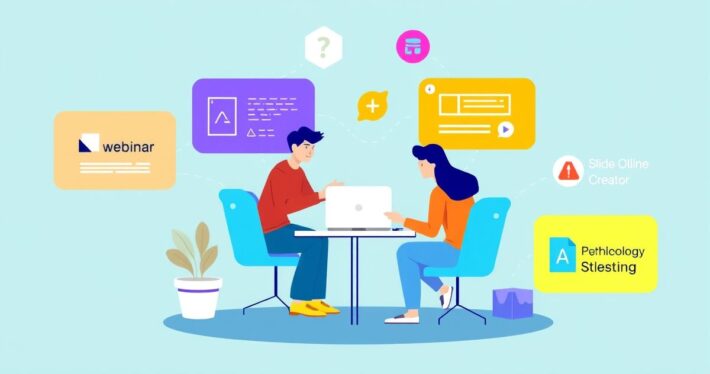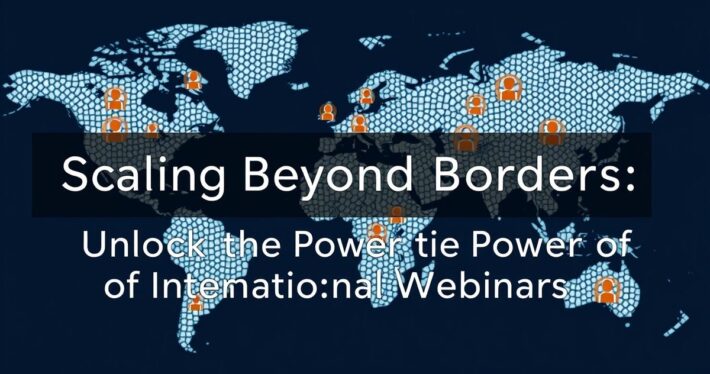Scaling up: The systems that successful webinar teams use.

Scaling Up: The Systems That Successful Webinar Teams Use
Webinars have become a powerhouse marketing tool for businesses looking to engage audiences, build authority, and drive conversions. But let’s be honest—going from hosting one-off webinars to scaling a webinar program isn’t just about hitting the “record” button. It requires the right systems, tools, and strategic workflows to ensure consistency, quality, and growth.
Successful webinar teams don’t just wing it; they rely on proven systems to streamline processes, automate repetitive tasks, and optimize for maximum ROI. Whether you’re a solopreneur or part of a larger team, scaling your webinar operations is achievable with the right approach. Here’s how the pros do it.
The Foundation: Building a Repeatable Workflow
Think of your webinar process like a well-oiled machine. Every part needs to function smoothly to get the desired outcome. Successful teams start by creating a repeatable workflow that ensures consistency across every webinar—from planning to post-event follow-up.
Here’s a breakdown of the essential components:
- Pre-Webinar Planning
- Define goals (e.g., lead generation, product launch, education).
- Create a content outline that balances education and engagement.
- Schedule promotional activities like email campaigns and social media posts.
- Execution
- Use reliable webinar platforms with features like polls, Q&A, and chat.
- Test all equipment and software beforehand to avoid technical glitches.
- Post-Webinar Follow-Up
- Send automated follow-up emails with replay links and additional resources.
- Analyze performance metrics like attendance rates, engagement, and conversions.
One real-world example? A SaaS company I worked with scaled their webinar program by standardizing their workflow templates. They created a checklist for every stage of the process—ensuring nothing fell through the cracks. The result? A 30% increase in attendance and a 20% boost in post-webinar conversions.
Automation: The Secret Sauce to Scaling
Automation isn’t just a buzzword; it’s a game-changer when it comes to scaling webinar operations. Here’s where it gets interesting: automating repetitive tasks frees up your team to focus on strategy and creativity.
For instance, webinar teams often use email automation tools to:
- Send reminder emails to registrants.
- Deliver post-webinar follow-ups with call-to-action (CTA) links.
- Nurture leads with targeted content sequences.
But automation doesn’t stop at emails. Tools like Zapier and Pabbly can integrate your webinar platform with your CRM, ensuring seamless data flow and enabling personalized follow-ups.
Leveraging AI-Powered Tools
AI is transforming the webinar landscape, making it easier than ever to create high-quality, engaging content. Here are some tools that successful teams swear by:
-
Slide Outline Creator
Struggling to structure your webinar content? AI-powered slide outline creators help you craft presentations that educate and engage. These tools analyze your topic and generate a logical flow, saving you hours of prep time. -
Offer Builder
What’s the point of a webinar if it doesn’t convert? AI-driven offer builders help you structure your pitch, stack value, and position your offer in a way that makes it irresistible. -
Bonus Brainstormer
Adding high-value bonuses can significantly boost conversions. AI tools can generate creative bonus ideas tailored to your audience, making your offer impossible to refuse. -
Guarantee Generator
Risk reversal is key to closing sales. AI-powered guarantee generators help you craft compelling guarantees that make saying “yes” feel like the safest choice.
Metrics that Matter: Tracking Performance
Scaling isn’t just about doing more; it’s about doing better. Successful webinar teams obsess over metrics to refine their strategies. Here’s what you should track:
-
Registration Rate
Are your promotional efforts driving sign-ups? -
Attendance Rate
How many registrants actually show up? -
Engagement Metrics
Are participants interacting with polls, Q&A, and chat? -
Conversion Rate
How many attendees take the desired action?
Analyzing these metrics helps you identify what’s working—and what’s not. For example, if your attendance rate is low, it might be time to reevaluate your webinar timing or promotional strategy.
Case Study: How a Fitness Brand Scaled Their Webinar Program
Let me share a story that illustrates these principles in action. A fitness brand wanted to scale their webinar program to promote their new online coaching platform. Here’s what they did:
-
Built a Repeatable Workflow
They created a standard operating procedure (SOP) for every webinar, ensuring consistency across all events. -
Leveraged Automation
They used email automation to send reminder emails and follow-ups, freeing up their team to focus on content creation. -
Adopted AI Tools
They used an AI-powered slide outline creator to streamline their content prep and an offer builder to craft irresistible pitches. -
Tracked Metrics
They closely monitored attendance and conversion rates, making adjustments as needed.
The result? A 50% increase in webinar attendance and a 40% boost in sales within three months.
Common Pitfalls and How to Avoid Them
Scaling your webinar program isn’t without its challenges. Here are some common pitfalls and how to avoid them:
-
Overcomplicating the Process
Keep your workflows simple and focused. Too many moving parts can lead to confusion and inefficiency. -
Neglecting Rehearsals
Technical issues can derail even the best-planned webinar. Always conduct a dry run to iron out any kinks. -
Ignoring Follow-Ups
The real magic happens after the webinar. Don’t forget to nurture your leads with thoughtful follow-ups.
Final Thoughts: Scaling with Confidence
Scaling your webinar program isn’t about working harder; it’s about working smarter. By building repeatable workflows, leveraging automation, and adopting AI-powered tools, you can deliver high-quality webinars consistently—without burning out.
So, are you ready to take your webinar game to the next level? Start by implementing the systems outlined here, and you’ll be well on your way to creating a scalable, high-performing webinar program.



